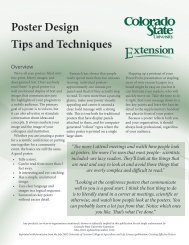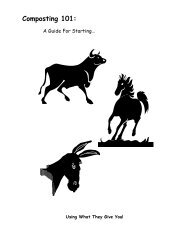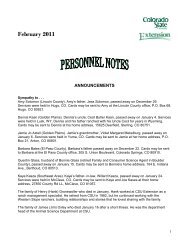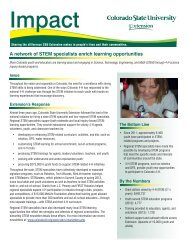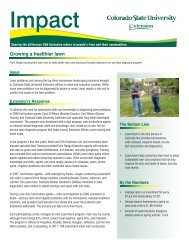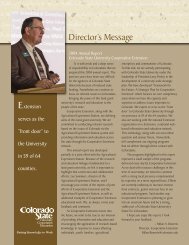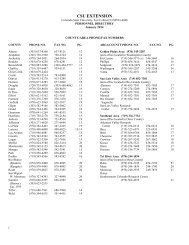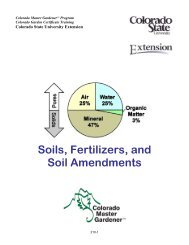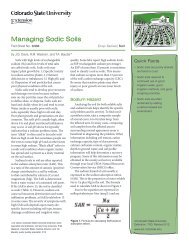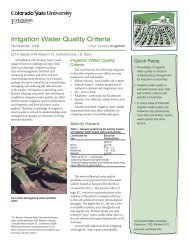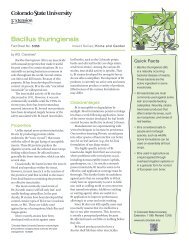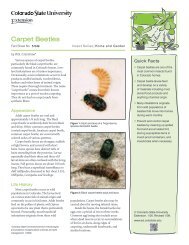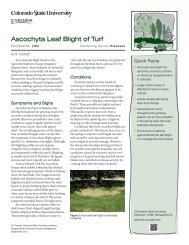PROJECT HANDWASHING - Colorado State University Extension
PROJECT HANDWASHING - Colorado State University Extension
PROJECT HANDWASHING - Colorado State University Extension
You also want an ePaper? Increase the reach of your titles
YUMPU automatically turns print PDFs into web optimized ePapers that Google loves.
Picture used by permission of Brevis Corp. www.brevis.com<br />
Objectives:<br />
To teach elementary school age youth the importance of hand washing, including<br />
how and when to wash their hands.<br />
Background Information :<br />
Hand washing is the least expensive, most effective way to prevent the spread of<br />
germs. A study of 305 Detroit children found that youngsters who washed their<br />
hands four times a day had 24% fewer sick days due to respiratory illness and<br />
51% fewer days lost because of stomach upset. The teachers had children wash<br />
their hands on arrival, before lunch, after recess, and before leaving for the day.<br />
Young children are at increased risk for contracting infectious diseases for<br />
many reasons.<br />
• When grouped together, they are exposed to many new germs.<br />
• Their immune systems are not fully developed to fight germs.<br />
• They do not have complete control of their body fluids that contain germs.<br />
• They have personal habits that spread germs, such as thumb sucking, putting<br />
things in their mouths, and rubbing their eyes.<br />
Teach children to wash their hands:<br />
<strong>PROJECT</strong> <strong>HANDWASHING</strong><br />
LEADER’S GUIDE<br />
Prepared by<br />
Sheila D. Ryan, CSU <strong>Extension</strong> Agent<br />
Patricia Kendall, CSU <strong>Extension</strong> Specialist &<br />
Melissa Bardsley, CSU Associate <strong>Extension</strong> Specialist<br />
COLORADO STATE UNIVERSITY COOPERATIVE EXTENSION<br />
January 2001<br />
• Before eating or making something to eat<br />
• After using the bathroom<br />
• After playing outside<br />
• After playing with pets<br />
• After blowing their noses<br />
• After coughing or sneezing (Talk about the use of the inside of your elbow<br />
when you cough or sneeze)<br />
• Whenever their hands look, feel or smell unclean<br />
1
When washing hands, children should:<br />
• Wash for 20 seconds, using warm running water and liquid soap<br />
• Scrub palms, backs, between fingers, fingernails, wrists and thumbs<br />
• Turn off the faucet with a paper towel to avoid recontamination<br />
• Thoroughly dry hands, preferably with a paper towel<br />
In addition, children should keep fingernails short and clean and use hand lotion<br />
to prevent dry cracking skin.<br />
Information on bacteria:<br />
Bacteria are everywhere. You have more bacteria on your body than there are<br />
people in the United <strong>State</strong>s. Bacteria, like people, can be either good or bad.<br />
There are bacteria that live on our skin and are usually not harmful. But your<br />
hands can gather all kinds of bacteria with each job they do. Like using the<br />
telephone, opening doors, or handling money. Bacteria can be removed by<br />
washing your hands and scrubbing your fingernails.<br />
We can’t see individual bacteria without using a microscope. If they are allowed<br />
to grow and multiply on agar, we can see them. Agar is a special food used to<br />
grow bacteria in the laboratory. It contains food for the bacteria to grow and<br />
reproduce. By transferring bacteria to an agar plate and keeping it warm, the<br />
bacteria will reproduce rapidly. There will be so many we can see them without a<br />
microscope.<br />
Note: You may want to inoculate an agar plate with your unwashed hands<br />
several days prior to teaching. Tape the dish closed and keep in warm place. You<br />
can show the children what colonies of bacteria look like.<br />
Lesson Procedure:<br />
A day or two prior to the hand washing class, request that the teacher give the<br />
pictorial quiz to the class. The teacher should ask the students to: 1) Write<br />
their name on the top of the page, and 2) Circle the picture(s) if the person<br />
in the picture needs to wash his/her hands.<br />
2
1. Introduction:<br />
Greet the class and introduce yourself. Instructor says: I am going to tell you a<br />
story called Germs! Germs! Germs! Note: This story is most appropriate for<br />
grades 1-3. For older grades omit this story and engage the class in the following<br />
discussion of bacteria (germs). After the story introduce BAC.<br />
Instructor says: I want to introduce BAC. Show the BAC hand puppet. BAC is<br />
short for bacteria, another name for germ. He is a pretend germ and maybe<br />
what some germs look like if we could see them.<br />
Engage the class in germ (bacteria) discussion. Questions to ask the class:<br />
• Has anyone heard of a germ? A germ is so small that we can’t see it with our<br />
eyes. Germs are everywhere, on your desk, on the floor, outside, and<br />
especially they are on our hands.<br />
• What can happen if germs get inside us? They can make us sick. They are<br />
having a good time, but we don’t feel well.<br />
• Has anyone been sick this year? Is it fun? We get sick when germs get<br />
inside our body<br />
• How can germs get inside our bodies? If we rub our eyes or touch our nose<br />
or mouth with our hands, then germs can get inside us. But if we wash our<br />
hands before we eat or before touching our eyes or mouth, then we can stop<br />
them from getting inside our body.<br />
So BAC wants to know what is the best way to fight BAC (bacteria) like him and<br />
keep from getting sick? WASH OUR HANDS.<br />
• Bac wants to tell you when you should wash your hands?<br />
Before eating or making something to eat<br />
After using the bathroom<br />
After playing outside<br />
After playing with pets<br />
After blowing their noses<br />
After coughing or sneezing (Talk about the use of the inside of your elbow<br />
when you cough or sneeze)<br />
3
1. Steps for Washing Hands (role play) Note: Use this activity for grades 1-3.<br />
For older grades use the video entitled, All Hands on Deck – True<br />
Confessions of a filthy, rotten disgusting GERM available in the “Project Hand<br />
washing” kit at the CSU <strong>Extension</strong> Office.<br />
Let’s pretend we are going to wash our hands. Place your feet in front of you and<br />
pretend we are walking to the sink. (Stomp feet)<br />
1. What is the first thing we are going to do?<br />
Turn the water on! A little cold and a little hot to make the water warm.,<br />
(Pretend to turn the faucet nobs)<br />
2. What do we do next?<br />
Put our hands under the warm water and get our hands wet. (Pretend to put<br />
hands under the water)<br />
3. Then what do we do?<br />
Now we put soap on our hands and make lots of bubbles, scrub our hands,<br />
rub our hands together, get in between our fingers and wash the backs of our<br />
hands and under our fingernails. (Pretend to wash hands)<br />
4. Now we do what?<br />
Rinse our hands off, getting those bubbles all rinsed off. (Pretend to rinse off<br />
the soap)<br />
5. The last thing we do is…?<br />
Dry our hands with a paper towel and turn off the water faucets. Use the<br />
towel to open the door, then throw away the paper towel.<br />
3. Wash Hands and View under UV light<br />
While half of the class works on this activity, the other half can work on the<br />
coloring book or activity book. Note: The coloring book and Germbusters<br />
Activities 1- 6 are most appropriate for first through third grades. For older<br />
grades omit the coloring book and use Germbusters Activities 7- 10. The<br />
Germbusters Activity booklet is available from Brevis Corporation at<br />
http://www.brevis.com.<br />
Place a small amount of powder or lotion from the Glogerm or Glitterbug kit on<br />
each child’s hands. The children need to rub their hands together and then view<br />
their hands under the UV light.<br />
Instructor says: If you were playing outside and you could see the germs<br />
on your hands this is what they might look like. These are only pretend<br />
germs. They are not germs. Everyone take a turn getting pretend<br />
germs on your hands. Look at them under the UV light. Then let’s walk to<br />
the sink and wash our hands.<br />
4
Note: The students will need someone to help them at the sink to<br />
reinforce the proper way to wash hands. Ask the child to say or<br />
sing the ABC song to reinforce the 20-second rule for washing<br />
hands.<br />
After the children wash their hands, ask them to view their hands under the UV<br />
light again to see if they were able to remove all the pretend germs.<br />
4. Coloring Book Activity<br />
While half of the class is washing their hands, ask the other students to sit down<br />
and work on the coloring book or Germbusters Activity Book.<br />
5. Summarize Activity and Review Objectives<br />
Have the class come back together as a group for discussion. Questions to ask:<br />
• Who has clean hands now? (Ask for a show of hands)<br />
• When are the times we need to wash our hands?<br />
Before we eat<br />
Before making something to eat<br />
After playing outside<br />
After using the rest bathroom<br />
After playing with pets<br />
After coughing or sneezing<br />
• What do we need to wash our hands?<br />
With warm water and soap.<br />
6. Post Activity Illustration Quiz:<br />
Handout the post quiz and ask the students to 1) put their name on the quiz, and<br />
2) circle those pictures where the person in the picture needs to wash their<br />
hands. Collect all the pre and post quizzes and return to the CSU <strong>Extension</strong><br />
Office.<br />
Stickers:<br />
Congratulate class and pass out stickers.<br />
Follow up:<br />
Pre and post quizzes can be used to assess change in knowledge and this<br />
information is to be shared with the children’s teacher.<br />
5



